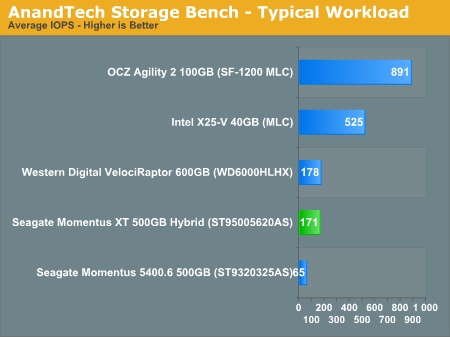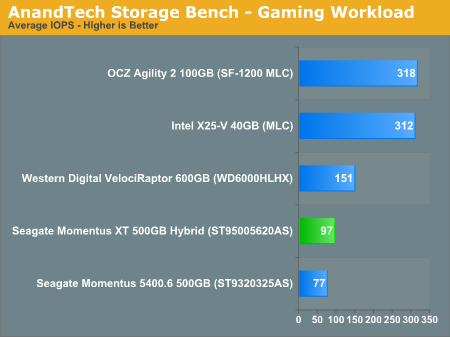Seagate's Momentus XT Reviewed, Finally a Good Hybrid HDD
by Anand Lal Shimpi on May 24, 2010 9:31 AM EST- Posted in
- Storage
- SSDs
- Seagate
- Momentus XT
- Hybrid Drive
- SSHDs
AnandTech Storage Bench
The first in our benchmark suite is a light usage case. The Windows 7 system is loaded with Firefox, Office 2007 and Adobe Reader among other applications. With Firefox we browse web pages like Facebook, AnandTech, Digg and other sites. Outlook is also running and we use it to check emails, create and send a message with a PDF attachment. Adobe Reader is used to view some PDFs. Excel 2007 is used to create a spreadsheet, graphs and save the document. The same goes for Word 2007. We open and step through a presentation in PowerPoint 2007 received as an email attachment before saving it to the desktop. Finally we watch a bit of a Firefly episode in Windows Media Player 11.
There’s some level of multitasking going on here but it’s not unreasonable by any means. Generally the application tasks proceed linearly, with the exception of things like web browsing which may happen in between one of the other tasks.
The recording is played back on all of our drives here today. Remember that we’re isolating disk performance, all we’re doing is playing back every single disk access that happened in that ~5 minute period of usage. The light workload is composed of 37,501 reads and 20,268 writes. Over 30% of the IOs are 4KB, 11% are 16KB, 22% are 32KB and approximately 13% are 64KB in size. Less than 30% of the operations are absolutely sequential in nature. Average queue depth is 6.09 IOs.
The performance results are reported in average I/O Operations per Second (IOPS):

Under typical multitasking workloads that aren't write intensive, the Momentus XT performs much like the new VelociRaptor. This isn't a typical notebook drive at all. We're still far away from even the cheapest SSDs though.
If there’s a light usage case there’s bound to be a heavy one. In this test we have Microsoft Security Essentials running in the background with real time virus scanning enabled. We also perform a quick scan in the middle of the test. Firefox, Outlook, Excel, Word and Powerpoint are all used the same as they were in the light test. We add Photoshop CS4 to the mix, opening a bunch of 12MP images, editing them, then saving them as highly compressed JPGs for web publishing. Windows 7’s picture viewer is used to view a bunch of pictures on the hard drive. We use 7-zip to create and extract .7z archives. Downloading is also prominently featured in our heavy test; we download large files from the Internet during portions of the benchmark, as well as use uTorrent to grab a couple of torrents. Some of the applications in use are installed during the benchmark, Windows updates are also installed. Towards the end of the test we launch World of Warcraft, play for a few minutes, then delete the folder. This test also takes into account all of the disk accesses that happen while the OS is booting.
The benchmark is 22 minutes long and it consists of 128,895 read operations and 72,411 write operations. Roughly 44% of all IOs were sequential. Approximately 30% of all accesses were 4KB in size, 12% were 16KB in size, 14% were 32KB and 20% were 64KB. Average queue depth was 3.59.

Crank up the sequential writes and you lose the benefit of the 4GB of SLC NAND on board the Momentus XT. It still delivers competitive performance with the X25-V thanks to the latter's limited write speeds, and it is faster than a conventional 2.5" drive as read operations still come off the NAND, but you don't get VelociRaptor performance out of it.
The gaming workload is made up of 75,206 read operations and only 4,592 write operations. Only 20% of the accesses are 4KB in size, nearly 40% are 64KB and 20% are 32KB. A whopping 69% of the IOs are sequential, meaning this is predominantly a sequential read benchmark. The average queue depth is 7.76 IOs.

As a benchmark that's bound by sequential read performance it's not surprising to see the Momentus XT not pull ahead here. Remember that we're limited by how quickly data can be streamed out of a single NAND device so you don't see a huge improvement in performance.










120 Comments
View All Comments
wagsbags - Monday, May 24, 2010 - link
Most SSDs use wear leveling algorithms or compression or some other fairly complicated mechanism to ensure reliability. Seagate wanted to make this as simple as possible while still being reliable.codedivine - Monday, May 24, 2010 - link
Here is a request for a test. What happens in dual-boot scenarios? If I boot into Windows 7 and then lets say into Ubuntu, then I expect the drive will have some trouble determining what to cache in its relatively small 4GB NAND.teohhanhui - Monday, May 24, 2010 - link
"The drive looks at access patterns over time (most likely via a history table of LBAs and their frequency of access) and pulls some data into the NAND. If a read request comes in for an LBA that is present in the NAND, it's serviced out of the 4GB chip. If the LBA isn't present in the NAND, the data comes from the platters."It should not matter what OS you're using.
leexgx - Monday, May 24, 2010 - link
it works at an very low level at LBAbelow is simplified
if LBA 50 is accessed say 2 times or more it then gets added to the flash if LBA 50 is over written it invalidates the LBA 50 block from the flash (its bit more then what i have say but basically what it does)
this drive does not talk to the OS at all when putting stuff onto the flash it makes an history of what parts of the disk are accessed the most and puts it on the flash (FIle or not)
the disk does not care what OS is running as its only looking at the History of the LBA access on the hdd side of this drive, so there should no issues using these drives in raid as it works at the LBA level of whats accessed the most
even better as each drive has 4gb of cache on them and raid 0 spreads data across muti disks the flash can be 4gb x N1 so if you have 4 XT drives you have 16gb of read cache flash available so if you open or use upto 16gb of files/LBA blocks that norm never change and are in use often they be cached so most of the reads come from the flash and Writes would goto the disk (if an Write and read are going on often the spinning disk maybe often only Writing most of the time as the reads would come from the flash)
nafhan - Monday, May 24, 2010 - link
The hard drive's firmware controls what gets cached. If you went back and forth between two OS's, you'd probably end up with either one or neither of them cached. The article explains that the best case scenario for a hybrid drive is where your most frequently used applications can fit within the 4GB of flash memory.Exelius - Monday, May 24, 2010 - link
Any chance of seeing a desktop version of this drive?While I know you prefer the discrete SSD+RAID solution, there's something to be said for simplicity (from an end user perspective; at least.) I would personally love to see a 1TB drive with around 32 GB of NAND for around $200. Given that both 1TB drives and 32GB SSDs are available for under a bill, this should be doable, right?
And on a different note; I'd be interested in seeing how a similar drive with a much larger flash cache performs in an enterprise scenario. Would the sync algorithm kill performance? Or would a larger cache allow wear leveling to make up for an increase in IOPS?
YellowWing - Monday, May 24, 2010 - link
I second that! 1 TB disk with 32 GB NAND for a reasonable price in a 3.5 inch form factor would get my dollar. Even if it were only a read cache.GourdFreeMan - Monday, May 24, 2010 - link
32GB of SLC would push the price of such a drive beyond $400 once manufacturer’s margins are taken into account with current generation flash. If MLC could be used instead, the price might be pushed down into the $250 range for your hypothetical drive, but it would have to cache data far less frequently to avoid wearing out the flash (or have to include a real SSD-like controller and some extra flash as spare area, once again driving up the price).mwagers - Monday, May 24, 2010 - link
Hows the vibration? I am trying to find a HD for my macbook pro and cant seem to find a 7200 that doesnt vibrate the casing. How does this one fair?JohnnyComeLately - Monday, June 6, 2011 - link
I just put this drive in my 15" MacBook Pro. There is a slight increase, but it's very very slight. What I think you'll notice more over the OEM drive is the noise. When the fans are off, and I'm in a quiet room, normally my MBP makes nearly no noise. I can hear this Momentus' platter spinning. It's not obnoxious, bad, but you will notice it if you're in a quiet room.